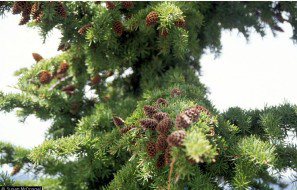Mountain hemlock is valued for its ability to protect watershed.
Photo Credit: © Susan McDougall, USDA-NRCS PLANTS Database.
Tsuga mertensiana
Common Name: mountain hemlock
Other Common Names: alpine hemlock, black hemlock, hemlock spruce
Plant Functional Group: Evergreen conifer
Class > Order > Family: Pinopsida > Pinales > Pinaceae
